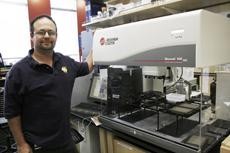Matthew Kaplan is looking for volunteers. But not just anyone: he’s looking for people with close family members who survived or were victims of the Holocaust.
Kaplan, a research coordinator at the UA’s Arizona Research Laboratories, is heading up the DNA Shoah Project, an effort that aims to reunite families separated by the Holocaust by creating an enormous genetic database out of samples from any and all living Holocaust survivors and their families.
“”This is an opportunity where the math is simple,”” Kaplan said. “”If everyone who was a candidate for this project would give a cheek brush, we would reconnect all the families that could be connected.””
Eligible individuals can request a free cheek swab, which they send back to ARL in the mail, Kaplan said. Those samples are then processed using the same cutting-edge genotyping technology ARL already has in place for other types of human genotyping projects.
While the science is relatively easy, the project has faced a more difficult hurdle: actually collecting samples.
“”The irony of this project is that the biggest challenges are not genetics challenges,”” Kaplan said. “”The biggest challenges are information and messaging challenges. Our biggest challenge is telling people that (the project) is even in existence.””
Lynn Davis, the project’s information specialist, agreed.
“”We’re hoping for and counting on a fair amount of word-of-mouth,”” she said.
The project – which is funded by the UA, private donors and a grant from California biotechnology developer Invitrogen Corp. – has already received about 1,000 samples during the two years since its inception, Kaplan said. However, he added that about 10,000 samples would be needed before any kind of definitive assessments could be made.
Another aspect of the project is an educational curriculum the researchers hope to make available free online for science teachers who want to use the Holocaust as a context for teaching students about genetics and forensics.
However, the project is strictly “”for the living,”” Kaplan said.
He stressed that there are no plans to sample any human remains, which he described as an ethical issue outside the jurisdiction of science. However, he said that the database would be designed in such a way that it would be accessible to groups who do decide to genotype the deceased.
An attempt to create an exhaustive genetic database of Holocaust survivors has never been attempted before, Davis said, in part because the technology being used didn’t exist until recently. But with that technology comes a responsibility, she said.
“”I think that given the technology and the expertise at our disposal, it would be irresponsible not to (do this project),”” she said. “”People often ask, ‘Why now?’ and the answer is because we can. The technology to do this kind of thing didn’t even exist five years ago.””
An added challenge, Kaplan said, is that data for the project is increasingly hard to come by.
“”This is the last chance,”” he said. “”Holocaust survivors die every day. Every generation, you lose half of the data.””
Ultimately the motivation for the project is the desire to get back some of what was stolen from Holocaust victims so many years ago, Kaplan said.
“”We live in a political climate where there are still Holocaust deniers,”” Kaplan said. “”So being able to attach some rigorous data to this is great. Being able to stitch together families that the Nazis tore apart, that’s great too. This is a project for anyone who lost family in that geographic area in that moment of history. If there is a chance that these people are out there, that’s why you’re gonna do this.””









